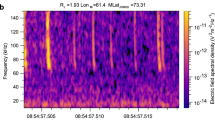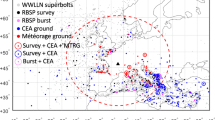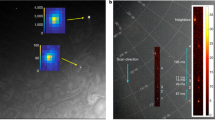Abstract
Electrical currents in atmospheric lightning strokes generate impulsive radio waves in a broad range of frequencies, called atmospherics. These waves can be modified by their passage through the plasma environment of a planet into the form of dispersed whistlers1. In the Io plasma torus around Jupiter, Voyager 1 detected whistlers as several-seconds-long slowly falling tones at audible frequencies2. These measurements were the first evidence of lightning at Jupiter. Subsequently, Jovian lightning was observed by optical cameras on board several spacecraft in the form of localized flashes of light3,4,5,6,7. Here, we show measurements by the Waves instrument8 on board the Juno spacecraft9,10,11 that indicate observations of Jovian rapid whistlers: a form of dispersed atmospherics at extremely short timescales of several milliseconds to several tens of milliseconds. On the basis of these measurements, we report over 1,600 lightning detections, the largest set obtained to date. The data were acquired during close approaches to Jupiter between August 2016 and September 2017, at radial distances below 5 Jovian radii. We detected up to four lightning strokes per second, similar to rates in thunderstorms on Earth12 and six times the peak rates from the Voyager 1 observations13.
This is a preview of subscription content, access via your institution
Access options
Access Nature and 54 other Nature Portfolio journals
Get Nature+, our best-value online-access subscription
$29.99 / 30 days
cancel any time
Subscribe to this journal
Receive 12 digital issues and online access to articles
$119.00 per year
only $9.92 per issue
Buy this article
- Purchase on Springer Link
- Instant access to full article PDF
Prices may be subject to local taxes which are calculated during checkout



Similar content being viewed by others
Change history
20 June 2018
In the version of this Letter originally published, in the second sentence of the last paragraph before the Methods section the word ‘altitudes’ was mistakenly used in place of the word ‘latitudes’. The sentence has now been corrected accordingly to: ‘Low-dispersion class 1 events indicate that low-density ionospheric regions predominantly occur in the northern hemisphere at latitudes between 20° and 70°.’
References
Storey, L. R. O. An investigation of whistling atmospherics. Phil. Trans. R. Soc. Lond. A 246, 113–141 (1953).
Gurnett, D. A., Shaw, R. R., Anderson, R. R., Kurth, W. S. & Scarf, F. L. Whistlers observed by Voyager 1: detection of lightning on Jupiter. Geophys. Res. Lett. 6, 511–514 (1979).
Smith, B. A. et al. The Jupiter system through the eyes of Voyager 1. Science 204, 951–957 (1979).
Borucki, W. J. & Magalhaes, J. A. Analysis of Voyager 2 images of Jovian lightning. Icarus 96, 1–14 (1992).
Little, B. et al. Galileo images of lightning on Jupiter. Icarus 142, 306–323 (1999).
Dyudina, U. A. et al. Lightning on Jupiter observed in the Hα line by the Cassini imaging science subsystem. Icarus 172, 24–36 (2004).
Baines, K. H. et al. Polar lightning and decadal-scale cloud variability on Jupiter. Science 318, 226–229 (2007).
Kurth, W. S. The Juno Waves Investigation. Space Sci. Rev. 213, 347–392 (2017).
Bolton, S. J., Levin, S. M. & Bagenal, F. Juno’s first glimpse of Jupiter’s complexity. Geophys. Res. Lett. 44, 7663–7667 (2017).
Bolton, S. J. et al. Jupiter’s interior and deep atmosphere: the initial pole-to-pole passes with the Juno spacecraft. Science 356, 821–825 (2017).
Connerney, J. E. P. et al. Jupiter’s magnetosphere and aurorae observed by the Juno spacecraft during its first polar orbits. Science 356, 826–832 (2017).
Fiser, J., Chum, J., Diendorfer, G., Parrot, M. & Santolik, O. Whistler intensities above thunderstorms. Ann. Geophys. 28, 37–46 (2010).
Kurth, W. S., Strayer, B. D., Gurnett, D. A. & Scarf, F. L. A summary of whistlers observed by Voyager 1 at Jupiter. Icarus 61, 497–507 (1985).
Santolík, O., Parrot, M. & Chum, J. Propagation spectrograms of whistler-mode radiation from lightning. IEEE Trans. Plasma Sci. 36, 1166–1167 (2008).
Williams, M. A. An Analysis of Voyager Images of Jovian Lightning (Univ. Arizona, University Microfilms International, Ann Arbor, 1986).
Gierasch, P. et al. Observation of moist convection in Jupiter’s atmosphere. Nature 403, 628–30 (2000).
Rinnert, K. et al. Measurements of radio frequency signals from lightning in Jupiter’s atmosphere. J. Geophys. Res. Planets 103, 22979–22992 (1998).
Connerney, J. E. P., Acuña, M. H., Ness, N. F. & Satoh, T. New models of Jupiter’s magnetic field constrained by the Io flux tube footprint. J. Geophys. Res. Space Phys. 103, 11929–11939 (1998).
Tetrick, S. S. et al. Plasma waves in Jupiter’s high-latitude regions: observations from the Juno spacecraft. Geophys. Res. Lett. 44, 4447–4454 (2017).
Kurth, W. S. et al. A new view of Jupiter’s auroral radio spectrum. Geophys. Res. Lett. 44, 7114–7121 (2017).
Brown, S. et al. Prevalent lightning sferics at 600 megahertz near Jupiter’s poles. Nature https://doi.org/10.1038/s41586-018-0156-5 (2018).
Scarf, F. L., Gurnett, D. A., Kurth, W. S., Anderson, R. R. & Shaw, R. R. An upper bound to the lightning flash rate in Jupiter’s atmosphere. Science 213, 684–685 (1981).
Lewis, J. S. Lightning on Jupiter: rate, energetics, and effects. Science 210, 1351–1352 (1980).
Christian, H. J. Global frequency and distribution of lightning as observed from space by the Optical Transient Detector. J. Geophys. Res. 108, 4005 (2003).
Ingersoll, A., Gierasch, P., Banfield, D. & Vasavada, A. Moist convection as an energy source for the large-scale motions in Jupiter’s atmosphere. Nature 403, 630–632 (2000).
Santolík, O. et al. Survey of Poynting flux of whistler mode chorus in the outer zone. J. Geophys. Res. 115, 1–13 (2010).
Connerney, J. E. P. et al. The Juno Magnetic Field Investigation. Space Sci. Rev. 213, 39–138 (2017).
Gurnett, D. A. & Bhattacharjee, A. Introduction to Plasma Physics With Space, Laboratory and Astrophysical Applications 2nd edn (Cambridge Univ. Press, Cambridge, 2017).
Hinson, D. P., Twicken, J. D. & Karayel, E. T. Jupiter’s ionosphere: new results from Voyager 2 radio occultation measurements. J. Geophys. Res. Space Phys. 103, 9505–9520 (1998).
Hinson, D. P. et al. Jupiter’s ionosphere: results from the First Galileo Radio Occultation Experiment. Geophys. Res. Lett. 24, 2107 (1997).
Acknowledgements
We acknowledge all members of the Juno mission team, especially the engineers and staff of the Juno Waves instrument. The research at the University of Iowa was supported by NASA through contract 699041X with the Southwest Research Institute. The work of I.K. and O.S. was supported by the MSM100421701 and LTAUSA17070 grants and the Praemium Academiae award.
Author information
Authors and Affiliations
Contributions
I.K. and M.I. independently performed extensive searches for Jovian rapid whistlers in the Waves burst dataset and combined the results in common list of events. M.I. and O.S. prepared the occurrence maps and calculated occurrence rates from this list. W.S.K., G.B.H. and D.A.G provided consultations on data analysis. W.S.K. is responsible for the Juno Waves instrument. J.E.P.C. provided the planetary magnetic field measurements. S.J.B. is principal investigator of the Juno spacecraft. The manuscript was written by O.S. and I.K. with input from all authors.
Corresponding author
Ethics declarations
Competing interests
The authors declare no competing interests.
Additional information
Publisher’s note: Springer Nature remains neutral with regard to jurisdictional claims in published maps and institutional affiliations.
Supplementary information
Supplementary Information
Supplementary Figures 1–10, Supplementary Tables 1–2, Supplementary Audio Guide
Supplementary Audio 1
Sound of whistler from Fig. 1a
Supplementary Audio 2
Sound of whistler from Fig. 1b
Supplementary Data 1
List of historical optical lightning detections on Jupiter
Supplementary Data 2
List of Jovian rapid whistlers observed by Juno
Rights and permissions
About this article
Cite this article
Kolmašová, I., Imai, M., Santolík, O. et al. Discovery of rapid whistlers close to Jupiter implying lightning rates similar to those on Earth. Nat Astron 2, 544–548 (2018). https://doi.org/10.1038/s41550-018-0442-z
Received:
Accepted:
Published:
Issue Date:
DOI: https://doi.org/10.1038/s41550-018-0442-z
This article is cited by
-
Lightning at Jupiter pulsates with a similar rhythm as in-cloud lightning at Earth
Nature Communications (2023)
-
Jupiter Science Enabled by ESA’s Jupiter Icy Moons Explorer
Space Science Reviews (2023)
-
Acoustic waves in the Jovian dusty magnetosphere: a brief review and meta-analysis
Reviews of Modern Plasma Physics (2022)
-
Atmospheric Electricity at the Ice Giants
Space Science Reviews (2020)
-
Plasma Wave Investigation (PWI) Aboard BepiColombo Mio on the Trip to the First Measurement of Electric Fields, Electromagnetic Waves, and Radio Waves Around Mercury
Space Science Reviews (2020)



